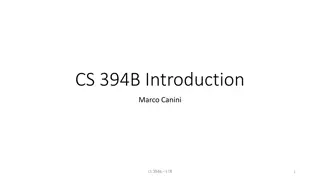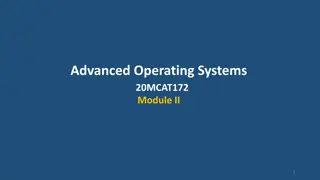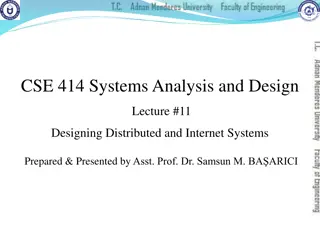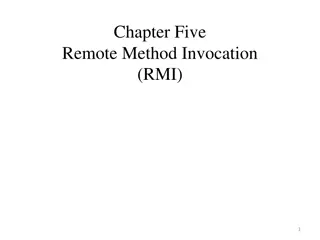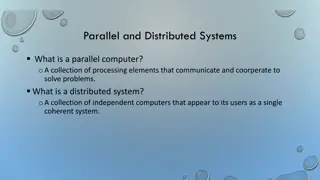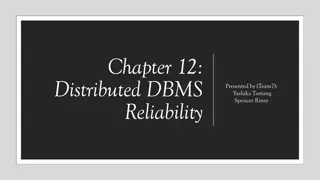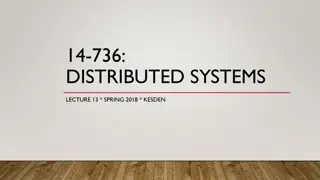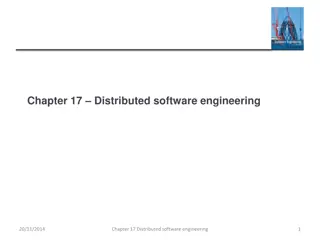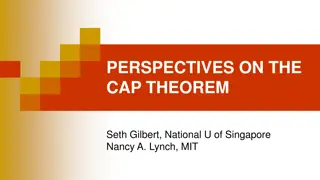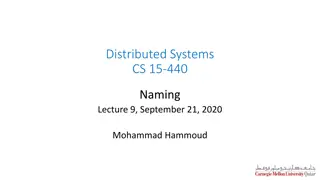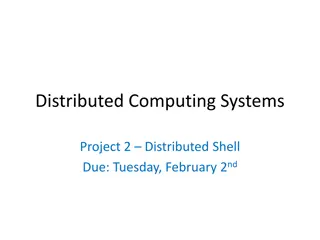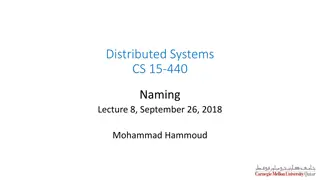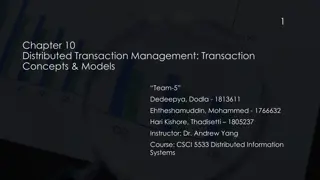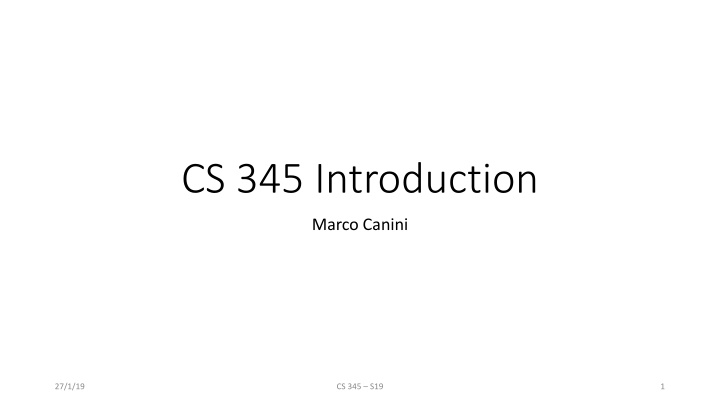
AI and ML in Distributed Systems
Learn about research in Distributed and Networked Systems with a main focus on AI/ML. Discover state-of-the-art solutions and work on impactful projects. Dive into formal methods, security, optimization theory, networking, and more to design scalable and dependable systems. Overcome challenges like complexity and apply a systems approach to build future-proof systems. Meet Marco Canini, an Assistant Professor at KAUST with research interests in cloud computing, data analytics, and machine learning.
Download Presentation

Please find below an Image/Link to download the presentation.
The content on the website is provided AS IS for your information and personal use only. It may not be sold, licensed, or shared on other websites without obtaining consent from the author. If you encounter any issues during the download, it is possible that the publisher has removed the file from their server.
You are allowed to download the files provided on this website for personal or commercial use, subject to the condition that they are used lawfully. All files are the property of their respective owners.
The content on the website is provided AS IS for your information and personal use only. It may not be sold, licensed, or shared on other websites without obtaining consent from the author.
E N D
Presentation Transcript
CS 345 Introduction Marco Canini 27/1/19 CS 345 S19 1
This Class Learn about research in Distributed and Networked Systems This year a main focus will be on AI/ML in connection to Systems Be exposed to the state-of-the art solutions to active areas Work on an exciting project Hopefully start next generation of impactful projects 27/1/19 CS 345 S19 2
About the Instructor Marco Canini Assistant Professor at KAUST since Aug 16 https://mcanini.github.io Research interests span Distributed and Networked systems in the context of cloud computing, large- scale data analytics, and machine learning Head of SANDS Lab Software-defined Advanced Networked and Distributed Systems Laboratory 27/1/19 CS 345 S19 3
My research Formal Methods Distributed Systems Security Machine Learning Optimization Theory Networking Software Engineering Programming Languages I design, build, measure and analyze large-scale networked systems that span multiple autonomous, potentially untrusted entities Goal: Discover and apply fundamental principles and valuable knowledge on how to build scalable, dependable and future-proof systems, worthy of society s trust 27/1/19 CS 345 S19 4
Challenges #1 Challenge: Complexity Hard to reason about behavior as systems scale to large numbers of components and users Poorly understood connections Need predictability to ensure scalable performance, reliable operation, etc. 27/1/19 CS 345 S19 5
Systems Approach Formulate problem Get idea Build prototype Measure & analyze Adjust prototype repeat previous step Principles of system construction modularity, hierarchy, layering, abstraction, end to end 27/1/19 CS 345 S19 6
SANDS Lab We develop techniques and abstractions for building scalable, dependable and future- proof systems, worthy of society s trust Our core interest is in the fundamental questions regarding the distributed network and software infrastructure necessary to support rich communication and compute systems for real-world applications such as cloud computing, large-scale data analytics, and machine learning We focus on interdisciplinary systems problems found in modern networked systems like large-scale datacenters, multi-Tbps Internet eXchange Points (IXPs), and the Internet of Things (IoT) We aim to determine the foundations of Software-Defined Infrastructure (SDI): fluid, planetary-scale software systems that are highly interconnected, deeply programmable, and virtualized within end-to-end slices across many administrative domains We build prototypes that directly improve the lives of real users and evaluate them on real-world workloads. 27/1/19 CS 345 S19 7
Example 1: Programmable Networks and Distributed Applications in Data Centers How can we co-design distributed systems with their network layer, and in doing so achieve substantial (performance) benefits? Proposer Proposer Alleviate Facilitate bottlenecks software Coordinator Coordinator Backup API Consensus protocols are a crucial building block used by essential services. Their performance is tied to assumptions about network behavior. Networks have recently changed: they are programmable! Acceptor Acceptor Acceptor Learner Learner Consensus at 9 M msgs / s and low latency s P4FPGA SDNet Netronome We showed that there are significant performance benefits to be gained by offering consensus as a network service. Forwarding 0.37 0.73 - Coordinator 0.72 1.21 0.33 0.01 Acceptor 0.79 1.44 0.81 0.01 8 27/1/19 CS 345 S19
Example 2: Predictable Performance of Distributed Systems How can we ensure that distributed systems offer predictable response times, especially at the tail of latency distribution? Server ? Client Server KV-store are a common building block to many data center applications. They provide reliable storage via replication and performance via scale-out to clusters. But selecting the right replica is crucial in the presence of many sources of performance variability! Server C3 Replica Ranking + Dist. Rate Control CS 345 S19 C3 improves Cassandra s latency profile at the mean and the tail by up to 3X at the 99.9th percentile, while improving read throughput by up to 50%. 27/1/19 9
Example 3: DAIET: Data Aggregation In nETwork The volume of distributed ML communication can be substantially reduced via in-network aggregation DAIET performs data aggregation along network paths using programmable network devices C G The aggregation function is +: it is commutative and associative Order independent D H E https://sands.kaust.edu.sa/daiet/ A B 10
What About You? Please introduce yourself! 27/1/19 CS 345 S19 11
About this class 27/1/19 CS 345 S19 12
Course Schedule Webpage: http://web.kaust.edu.sa/Faculty/MarcoCanini/classes/CS345/S19/ Piazza: http://piazza.com/kaust.edu.sa/spring2019/cs345 Meetings 4PM 5:30 PM (Sun/Wed for lectures and discussions) Pay attention to the online announcements and schedule On average, two meetings per week Makeups will be added on a need-to-add basis 27/1/19 CS 345 S19 13
Prerequisites CS 240 (Computing Systems and Concurrency) Basics of OS organization, threads, memory management, file systems, scheduling, networking, etc. Equivalent course of CS 240 is acceptable as well Basic knowledge of networking: e.g., CS 244 (Computer Networks) Basics of packet switching, Internet architecture and protocols, etc. Good programming skills Build substantial systems for course project Questions Have you taken a grad-level systems (e.g., OS, networking) course before? Have you worked on large systems-building project? 27/1/19 CS 345 S19 14
Course Requirements Paper Reviews Paper Presentation Participation Project 15% 20% 15% 50% Checkpoint #1: initial proposal 10% Checkpoint #2: midterm progress report 15% Final report 25% 27/1/19 CS 345 S19 15
Paper Reviews This is a paper-reading course Paper reviews account for 20% of the total grade 20-25 summaries to write What goes in a good summary? Highlight strengths Highlight weaknesses Describe the entire paper in few sentences See detailed guidelines on course website (or next slide) 27/1/19 CS 345 S19 16
Critical Reading What is the problem addressed by the paper? Is the problem real? Why is this problem important? What is the hypothesis of the work? What is the proposed solution s main idea, and what key insight guides their solution? Why is the solution different from previous work? Are system assumptions different? Is workload different? Is problem new? Does the paper (or do you) identify any fundamental/hard trade-offs? What is one (or more) drawback or limitation of the proposal, and how will you improve it? Do you think the work will be influential in 10 years? Why or why not? 27/1/19 CS 345 S19 17
What are Hard/Fundamental Tradeoffs? Brewer s CAP conjecture: Consistency, Availability, Partition- tolerance , you can have only two in a distributed system In a in-order, reliable communication protocol cannot minimize overhead and latency simultaneously Hard to simultaneously maximize evolvability and performance 27/1/19 CS 345 S19 18
How to Review You will see a section for describing a paper summary, its strengths, its weaknesses, and detailed comments In the summary section, please directly address: 1. What problem the paper is addressing (1-2 sentences or bullets) 2. The core novel ideas or technical contributions of the work (1-2 sentences or bullets). Put another way, what's the 30 second elevator pitch, or, five years from now, what should one remember about this paper? 3. A longer description (3-5 sentences) that summarizes the paper's approach, mechanisms, and findings For the other sections, please include 2-4 bullet points for the strengths and weaknesses, while a much longer exposition in the detailed comments (according to template on slide 16) Remember to be constructive: don't only focus on the paper's shortcomings, but also on what it could have done differently or as the next steps. Imagine that you are having a conversation with the authors: What would you tell them? 27/1/19 CS 345 S19 19
Reviewing Tips Read (if you haven t already!) How to Read a Paper by S. Keshav How to read a research paper by Michael Mitzenmacher Writing Reviews for Systems Conferences by Timothy Roscoe 27/1/19 CS 345 S19 20
Paper Reviews Reviews must be submitted electronically 24 hours before the class Submission site: https://hotcrp.kaust.edu.sa/cs345 You can miss at most 4 without any penalty Each missing one beyond that will result in 25% decrease in grade for this segment Meaning, missing 8 or more will result in 0% for the Paper Reviews segment of your grade At the end of the term, 2 of your reviews will be randomly selected and graded The higher grade of the two will be used for grading 27/1/19 CS 345 S19 21
Paper Presentation This is a seminar-style course Each student must present at least one papers Paper presentation account for 20% of the total grade Presenter to read mandatory and companion paper Presentation should last 45 minute without interruptions Though expect interruptions and questions Followed by discussion anchored by the presenters What should go in a useful presentation? See next slide Lead the discussion Go through the strengths and weaknesses from the paper review 27/1/19 CS 345 S19 22
Presentation Guidelines Motivate the paper and provide background Present the high level idea, approach, and/or insight (using examples, whenever appropriate) Discuss technical details so that one can understand the key details without carefully reading it Explain the difference between this paper and related work Raise questions throughout the presentation to generate discussion 27/1/19 CS 345 S19 23
Presentation Structure Your oral description of the paper should follow a much similar format: 1. System name (e.g., "VL2") | Institution and/or authors (e.g., "Microsoft Research") | Conference (e.g., "SIGCOMM 2009") 2. Problem 3. Core ideas 4. Descriptive summary, technical details and main results 5. Related work 6. Strengths 7. Weaknesses/limitations 8. Further discussion, including proposals for follow-up work 27/1/19 CS 345 S19 24
Paper Presentation Email your slides to the instructor 24 hours before the class Prepare early Practice a lot Also, read How to Give a Bad Talk by David A. Patterson Pointers for Leading Paper Discussions by Randy H. Katz Also, see How to Give a Great Research Talk by Simon Peyton Jones 27/1/19 CS 345 S19 25
Paper Review Website We will use the HotCRP conference software http://www.read.seas.harvard.edu/~kohler/hotcrp/ It is a system used by many real-word conferences, including USENIX conferences and many ACM SIGCOMM and SIGPLAN conferences Submission site: https://hotcrp.kaust.edu.sa/cs345 27/1/19 CS 345 S19 26
Participation Attend all lectures Can miss at most two with legitimate reasons Read all the papers and participate Ask questions! We evaluate class participation by observing how prepared students are to discuss the covered paper when they come to class 27/1/19 CS 345 S19 27
Project The biggest component of this course Original research Pick an interesting open problem. Why is it important? What has already been done? Why are they not enough? Develop a hypothesis about how you d improve it Intuitively, why will your approach work? Build a substantial prototype Experiment, measure, and compare against the state-of-the-art Reproduce a result from a systems paper Aim at producing a conference/workshop-quality research paper Can be related to your research topic but it is expected to be distinct! 27/1/19 CS 345 S19 28
Projects This is a research-oriented course! The final project accounts for 50% of total grades Done in groups of 2 students. Find your peers! What can and cannot be a project? Just surveys are not allowed. In fact, each project must include a survey of related work and background An ideal project should answer the questions you asked during paper reviews and points you cared about for presentations Measurements of new environments or of existing solutions on new environments are acceptable upon discussion 27/1/19 CS 345 S19 29
Original Research: How to Approach It? 1. Find a problem and motivate why this is worth solving 2. Survey background and related work to get a sense of your (friendly!) competition Might require you to go back to the first step 3. Form/update your hypothesis 4. Test your hypothesis Go back to 3 until you are happy 5. Present your findings in a presentation and in writing Discuss known limitations 27/1/19 CS 345 S19 30
Reproduction: How to Approach It? 1. Pick an interesting paper 2. Ask what kind of reproduction is appropriate? 3. Does the primary result of the paper hold up? 4. What happens if you vary a parameter the original experimenter didn t consider? 5. Having reproduced the primary result, can you now extend or improve the work? 6. What was difficult to reproduce? 27/1/19 CS 345 S19 31
Milestones Date Milestone 6/2/19 Form Group * Week of Details Find like-minded students 17/2/19 Draft Proposal Send your 2-page proposal by email 28/2/19Finalize Proposal Checkpoint #1 (10%) After a back-and-forth discussions with the instructor Midterm Progress Report Checkpoint #2 (15%) 6/4/19 4-page report should read like parts of a research paper Define and motivate a problem, survey related work, and form initial hypothesis and idea 7/4/19* Midterm Presentations 15/5/16 Final Presentation 18/5/16 Final Report (25%) Present your findings in a presentation 8-page final report similar to the papers you read 27/1/19 CS 345 S19 32
Draft Proposal Read: The Heilmeier s Catechism 2 pages including references that ideally includes The particular results you would like to replicate, or the overall goal of your original project What is the problem? | Why is it important to solve? What you will do in some detail?| How would you evaluate your solution? A brief outline of incremental steps to do to finish the project as well as a timeline The goal is to convince both us and yourself that your project is neither too small nor too big Include team members Meaning, form a group ASAP Schedule via email a 15-minute meeting to discuss 27/1/19 CS 345 S19 33
Finalized Proposal 4 pages including references that must include Have the structure of the final report Complete introduction written Status of the project Plan for the remaining time Approved by the instructor and agreed upon by you Forms the basis of expectation 27/1/19 CS 345 S19 34
Midterm Presentation In-class short presentation over one day (or two days if necessary) This is to make sure you are making progress Must include What is the problem? Why is it important? What are the most related work? What s your hypothesis so far? How are/will you evaluate it? 27/1/19 CS 345 S19 35
Final Presentation and Report Presentation It will follow a format similar to other presentations given in the class (20 min) Research paper The key part Should be written similar to the papers you ve read Your goal is to do publishable quality systems research Up to five best projects will be earmarked for expedited submission to a renowned conference, with the help of the instructor Also, submit self-contained code as a zip file Read: How to Write a Great Research Paper by Simon Peyton Jones 27/1/19 CS 345 S19 36
Rough Outline Abstract Introduction (Highlight the importance and give intuition of solution) Motivation (Use data and simple examples) Overview (Summarize your overall solution so that readers can follow later) Core Idea (Main contribution w/ challenges and how you address them) Implementation (Discuss non-obvious parts of your implementation) Evaluation (Convince readers that it works and when it fails) Related Work (Let readers know that you know your competition!) Discussion (Know your limitations and possible workarounds) Conclusion (Summarize and point out future work) 27/1/19 CS 345 S19 37
Regular Check-ins and Meetings Mandatory meeting around the time each milestone is due By appointment Also, send an update (via Piazza) each week to the instructor 1. what you did this week 2. which papers you read this week 3. what you need to do next week to stay on track These updates will not be graded; the idea is to make sure you are making incremental progress 27/1/19 CS 345 S19 38
Before We Move On Late work policy: no extensions Any exceptional circumstances, talk to us early Zero tolerance for academic misconduct Cheating, plagiarism, any form of dishonesty will be handled with maximum severity Slides will be posted after the class Everyone must come after reading all the assigned papers Class meeting format Quick summary by the instructor Presentation of typically two papers Followed by a short break Presenter leads discussions on the papers and related topics 27/1/19 CS 345 S19 39
Systems Research 27/1/19 CS 345 S19 40
What is systems research? Core areas: Operating systems Storage systems Networked systems Distributed systems And also their interactions with: Computer architecture Programming languages / compilers Theory and semantics (formal methods) Human-Computer Interaction Social science 27/1/19 CS 345 S19 41
Systems-research methodology Pursue hypotheses This protocol change will improve performance under packet loss This filesystem change will improve performance on flash devices Analyze, extend, or build artefacts Real systems (e.g., an OS kernel or storage system) Simulations (e.g., of a network topology or processor) Analytic models (e.g., of a scheduling algorithm or protocol) Evaluate behavior of the artefacts Compare to baselines / other hypotheses Measure quantitatively and qualitatively Performance, scalability, complexity, robustness, energy, security, 27/1/19 CS 345 S19 42
Experimentation for exploration vs. evaluation Similar methodologies, very different activities Exploration Understand and explain the behavior of a system Develop hypotheses about causal effects, potential changes Consider performing a limit study early in the project Evaluation Measure/explain [non-]conformance to hypotheses Clearly compare with competing approaches and control Explain why the approach worked (or didn t) 27/1/19 CS 345 S19 43
Thinking about evaluation Avoid existence proofs ( We built it. The end. ) Compare with other approaches Related work is not just a list of citations! Intellectual comparisons with approaches Compare experimentally Argue about benefits and costs of your approach Present tradeoffs very little is unconditionally better! Bad: We only looked at workload A and always win there Good: Approach X improves important workload A, but not B Realism How realistic must experiments be to convince the reader? 27/1/19 CS 345 S19 44
The experimental method (Bacon, ...) 1. 2. 3. 4. Make observations Form hypotheses about causality Make predictions Perform an experiment: Manipulate independent variables Hold other variables constant Measure dependent variables Compensate for random error Control for confounding variables Focus on reproducibility Analyze results of experiment Draw a conclusion Report results (e.g., variance such as timer ticks) (e.g., in-production experiments) 5. 6. 7. Read (if you haven t): Repeatability in computer systems research by C. Collberg and T. A. Proebsting 27/1/19 CS 345 S19 45
Some easier things you can measure Performance Throughput and/or latency? Scalability as cores/disks/nodes/links/packets... increase? Energy use? Resilience / robustness Packet loss? Network partition? Node failures? Disk failures? Compatibility / deployment realism Source-code / binary impact on affected applications? Protocol / format deployment scenarios? 27/1/19 CS 345 S19 46
Some harder things to measure Security Effect on past vulnerabilities? Trusted Computing Base (TCB) size? Automated reasoning / proofs? Services enabled by new security features? Maintenance burden / debuggability Potential costs of adoption / deployment? New kinds of bugs and mitigations for them? User experience User studies but they are hard! Identify proxies through real-system traces e.g., latency? 27/1/19 CS 345 S19 47
Bias, error, fidelity, and generality Analyze, minimize, and document error: Experimenter bias Random error / sampling effects Confounding variables / controls Probe and measurement effects Simulation fidelity / configuration realism Workload / benchmark realism Generality and scope of results Real-system measurements are samples in distributions Use statistics to interpret significance of results 27/1/19 CS 345 S19 48
Q&A That was a short introduction to systems research Read How to be a computer systems graduate student by Richard Martin 27/1/19 CS 345 S19 49
Credits In designing and running this course, I acknowledge inspirations from UIUC CS 525 by Indranil Gupta (Indy) Michigan EECS 582 by Mosharaf Chowdhury UCB CS 294 by Ion Stoica and Ali Ghodsi Cambridge Adv. Topics in Comp. Systems by Richard Mortier Lecture on Practical experiments in systems performance research by Robert N. M. Watson 27/1/19 CS 345 S19 50



